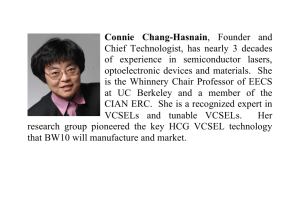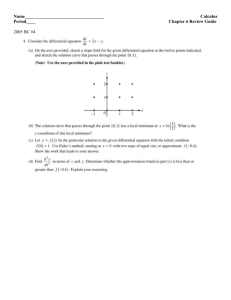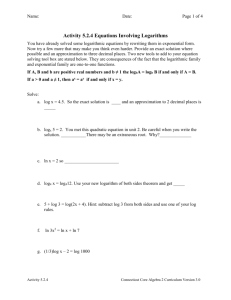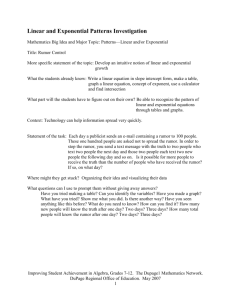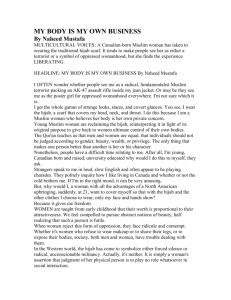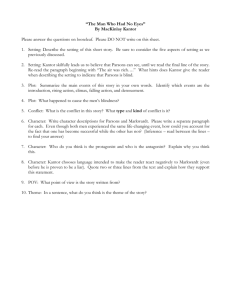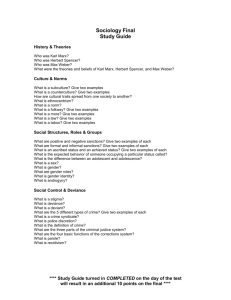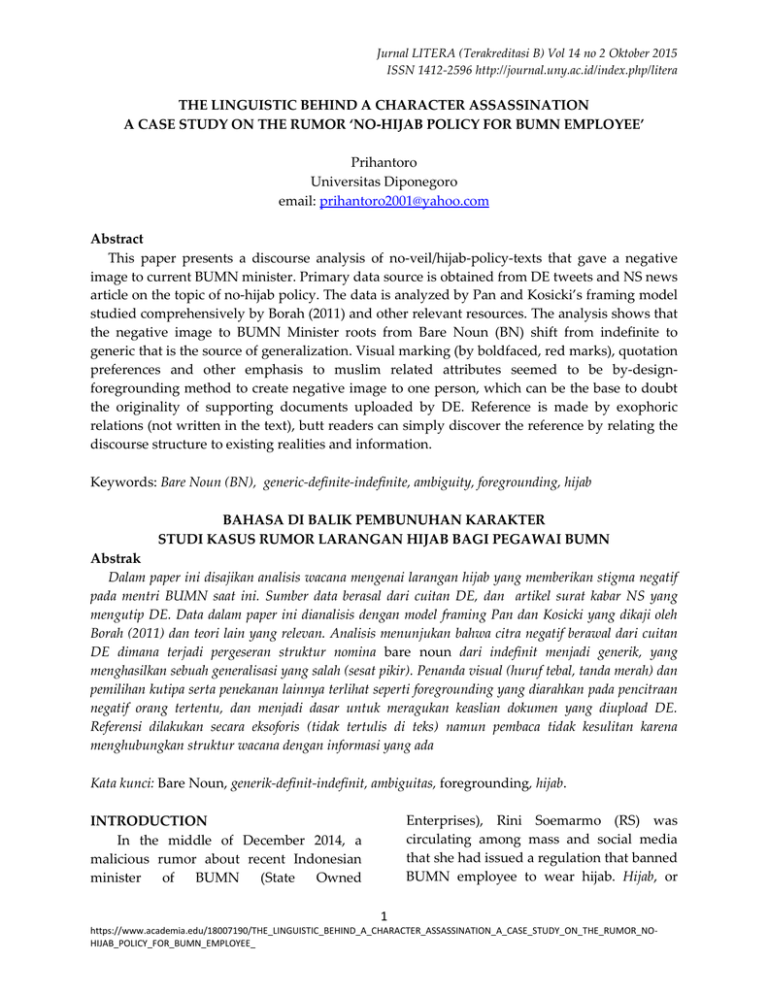
Jurnal LITERA (Terakreditasi B) Vol 14 no 2 Oktober 2015
ISSN 1412-2596 http://journal.uny.ac.id/index.php/litera
THE LINGUISTIC BEHIND A CHARACTER ASSASSINATION
A CASE STUDY ON THE RUMOR ‘NO-HIJAB POLICY FOR BUMN EMPLOYEE’
Prihantoro
Universitas Diponegoro
email: prihantoro2001@yahoo.com
Abstract
This paper presents a discourse analysis of no-veil/hijab-policy-texts that gave a negative
image to current BUMN minister. Primary data source is obtained from DE tweets and NS news
article on the topic of no-hijab policy. The data is analyzed by Pan and Kosicki’s framing model
studied comprehensively by Borah (2011) and other relevant resources. The analysis shows that
the negative image to BUMN Minister roots from Bare Noun (BN) shift from indefinite to
generic that is the source of generalization. Visual marking (by boldfaced, red marks), quotation
preferences and other emphasis to muslim related attributes seemed to be by-designforegrounding method to create negative image to one person, which can be the base to doubt
the originality of supporting documents uploaded by DE. Reference is made by exophoric
relations (not written in the text), butt readers can simply discover the reference by relating the
discourse structure to existing realities and information.
Keywords: Bare Noun (BN), generic-definite-indefinite, ambiguity, foregrounding, hijab
BAHASA DI BALIK PEMBUNUHAN KARAKTER
STUDI KASUS RUMOR LARANGAN HIJAB BAGI PEGAWAI BUMN
Abstrak
Dalam paper ini disajikan analisis wacana mengenai larangan hijab yang memberikan stigma negatif
pada mentri BUMN saat ini. Sumber data berasal dari cuitan DE, dan artikel surat kabar NS yang
mengutip DE. Data dalam paper ini dianalisis dengan model framing Pan dan Kosicki yang dikaji oleh
Borah (2011) dan teori lain yang relevan. Analisis menunjukan bahwa citra negatif berawal dari cuitan
DE dimana terjadi pergeseran struktur nomina bare noun dari indefinit menjadi generik, yang
menghasilkan sebuah generalisasi yang salah (sesat pikir). Penanda visual (huruf tebal, tanda merah) dan
pemilihan kutipa serta penekanan lainnya terlihat seperti foregrounding yang diarahkan pada pencitraan
negatif orang tertentu, dan menjadi dasar untuk meragukan keaslian dokumen yang diupload DE.
Referensi dilakukan secara eksoforis (tidak tertulis di teks) namun pembaca tidak kesulitan karena
menghubungkan struktur wacana dengan informasi yang ada
Kata kunci: Bare Noun, generik-definit-indefinit, ambiguitas, foregrounding, hijab.
Enterprises), Rini Soemarmo (RS) was
circulating among mass and social media
that she had issued a regulation that banned
BUMN employee to wear hijab. Hijab, or
INTRODUCTION
In the middle of December 2014, a
malicious rumor about recent Indonesian
minister
of
BUMN
(State
Owned
1
https://www.academia.edu/18007190/THE_LINGUISTIC_BEHIND_A_CHARACTER_ASSASSINATION_A_CASE_STUDY_ON_THE_RUMOR_NOHIJAB_POLICY_FOR_BUMN_EMPLOYEE_
Jurnal LITERA (Terakreditasi B) Vol 14 no 2 Oktober 2015
ISSN 1412-2596 http://journal.uny.ac.id/index.php/litera
jilbab, is a veil-like outfit that is an attribute
of female muslim.
Although later proven to be completed
unfounded, the rumor went viral on social
media. People sharing the rumor link their
statuses or comments to an on-line article
published by a small-scale newspaper, NonStop (NS). NS created the image of BUMN
minister as an anti-Islam and claim the
validity of their news from a tweet under
the account name of DE, which is affiliated
to an opposition party.
Although it is proven to be a
prevaricated news, what needs further
examination is how some people at that
period of time easily believe the rumor to be
true. The answer is twofold: the way the
texts interrelated and presented by the
author, and the less-critical reading by the
reader.
Linguistics here plays a central role, as
it might be the source of fallacies (Hurley,
2012). On one side, linguistics is not to
blame solely as it only projects author’s
rhetoric and intent. On the other side,
authors may also recreate realities in
different ways. Some information is
backgrounded, while some others are
foregrounded. Sometimes, information is
not presented completely and texts might be
organized in a way that assassinates one’s
character. At this point, readers cannot just
rely on texts and author’s honesty anymore.
This research significance is to make
people aware that reading texts critically is
important: both on the linguistic structures
and situational contexts. Texts, realities, and
author intents are one integrated entity.
Taking a text for granted, without critically
reviewing it might lead readers to false
conclusion(s).
The texts I analyze here are: 1) NS
article concerning no-hijab policy by the
Minister of BUMN (December 16, 2014), 2)
the summary of DE’s tweets which focus on
this rumor, and 3) the document that DE
claimed to support her arguments. The
tweets may be consisting of her solely,
along with uploaded photo, or with
responds from her followers. A series of
analysis in this paper will show how NS
and some readers took the inference
wrongly under the influence of the
discourse structure built by the authors of
the texts. The description will relate the
discourse structure by the concept of
genericity, definiteness, framing and
markedness.
I here argue that reasons for the wrong
inference may happen is the discourse
structure of the texts, which is represented
by 1) the narrative structure of NS article
and DE’s tweets, 2) the shift of BUMN from
indefinite to generic, and 3) the anti-islam
markings as shown by the use of negative
prosody words, graphical markings, and
quotation preference.
As one of my points is about how
readers generalize from details on the texts,
I believe it is important to review the
concepts of genericity and definiteness, and
how they apply in Indonesian (Chung,
2000). Bare noun is mostly known to
represent genericity, as in English and some
other languages. In English, an article might
be used to mark definiteness. However,
article is a linguistic device that is not
present in Indonesian language. See (1) and
its gloss in English:
(1) Presiden telah menaikkan harga BBM
President have raise price oil
‘the President has raised the oil price’
As Porter (2005) suggested, In English,
article ‘the’ must be present when the
2
https://www.academia.edu/18007190/THE_LINGUISTIC_BEHIND_A_CHARACTER_ASSASSINATION_A_CASE_STUDY_ON_THE_RUMOR_NOHIJAB_POLICY_FOR_BUMN_EMPLOYEE_
Jurnal LITERA (Terakreditasi B) Vol 14 no 2 Oktober 2015
ISSN 1412-2596 http://journal.uny.ac.id/index.php/litera
referent is definite. In (1) presiden refers to
only one particular president. See the VP
‘raised the oil price’, which does not apply
to all presidents.
Now, observe the same bare noun
presiden in (2). President in (1) and (2) are all
bare nouns. However, presiden in (1) is
definite [+DEF], while presiden in (2) is
generic [+GEN].
relate events that happen closely in time as
one sequence. See Mulyana (2008) and
Koffka (2013).
When encountering (1), I will not refer
to the previous president SBY (Susilo
Bambang Yudhono) although he also did an
exactly same thing. This is because, it
happened weigh more distance in the past.
Instead, I will refer to the current president,
Jokowi as it is shorter in distance.
This implies that bare noun in
Indonesian is processed covertly with highcontext. See (Chung, 2000). The same
phenomenon also applies in Malay (Carson,
2000) and Javanese (Asmaramurthi, 2008),
where null subject or bare noun can also be
definite with proper discourse context.).
This is quite different from languages like
English when definiteness is processed with
low-context (overt linguistic marker).
The consequence of the high-context
processing is that it relies heavily on the
realities and speaker-reader knowledge
where the knowledge may vary from
person to person. This spot may lead to
different interpretations among readers. Say,
when I am not aware of the information that
recent Indonesian president, Jokowi, has
raised the oil price, I might resort the bare
noun presiden to indefinite, and then raise a
question; ‘which president?’ or ‘is this
president Jokowi?’ or ‘is this the previous
president?’ when I understand the bare
noun definitely.
(2) Presiden memimpin sebuah negara
President lead one country
‘President leads a country’
In (2), presiden is generic as the VP
‘leads a country’ holds true for all
presidents. On the contrary, VP in (1) might
hold true only for some presidents (the
one(s) who raised the oil price); it does not
apply to all presidents. The question now is,
how can a bare noun be definite in
Indonesian? How can Indonesian speakers
distinguish that presiden is definite in (1)
and generic in (2)?
The answer is the relevant contexts and
the background knowledge of the readers.
When readers are faced with sentence in (1),
for instance a headline, they process the
linguistic structure; and when faced with
ambiguities, they will confirm the meaning
of the bare noun with realities and their
background knowledge. For instance, I have
the knowledge that President Jokowi (Joko
Widodo, The 7th and current president of
Indonesia ) announced that the government
officially reduced the subsidy for the oil
price. This information will validate my
decision to determine the bare noun in (1) as
definite. When this information is present,
readers will always try to relate this to the
event happening in the shortest timeframe.
This is parallel to the findings of some
studies that people will psychologically
(3) Presiden telah menaikan harga BBM
Presiden have raised price oil
‘a President has raised the oil price’
A bare noun in Indonesian, depending
on the context, might be generic, definite or
indefinite. However, often a false deduction
can happen even with a clear definite
3
https://www.academia.edu/18007190/THE_LINGUISTIC_BEHIND_A_CHARACTER_ASSASSINATION_A_CASE_STUDY_ON_THE_RUMOR_NOHIJAB_POLICY_FOR_BUMN_EMPLOYEE_
Jurnal LITERA (Terakreditasi B) Vol 14 no 2 Oktober 2015
ISSN 1412-2596 http://journal.uny.ac.id/index.php/litera
marker. This often involves ideology, which
is part of readers’ knowledge. Consider (4):
days, of course people would just say
doctor to refer to both male and female
doctors.
Another function of marking is for
emphasis or focus (Sinclair, 2003). When
someone goes to a hospital to see an
OB/GYN specialist, in the registrar, she
might ask the nurse ‘can I have a female
doctor to examine me? There, doctor is
marked by ‘female’ not because the doctor
is male in stereotype, but to emphasis her
preference, for instance, to examine her
private reproduction organ. Marking can
also be performed by graphics such as
highlight, boldfaced fonts or italic. In the
paper, I will show later how DE marked the
text with Islamic attributes like jilbab ‘hijab’
and jenggot ‘beard’. In communication
studies, this approach is known as framing
analysis. In this research, I applied Pan and
Kosicki’s model as studied by Borah (2011).
(4) The terrorist is an Arab
(5) All Arabs are terrorists
It is clear that the definite marker ‘the’ ,
which attaches to ‘terrorist’, implies that it is
a person in particular. The predicate ‘an
Arab’
describes
his/her
nationality.
However, people with an anti-arab ideology
often jump to the conclusion that all Arabs
are terrorists (5) without any prior critical
reading. The decision might also happen as
the person is always exposed to the visual
markings showing only terrorists from
Arabic/middle east countries. The decision
might be different when people were
exposed to multi-national terrorists news,
with the appearance that resembles
Caucasians, Africans or East Asians, for
example. Therefore, to understand a text
objectively, the linguistic of the text solely is
not sufficient.
Now, I will review how markedness
can also contribute to the data I discuss here.
However, I want to make myself clear first
that markedness here is defined by
pragmatics or discourse studies (Tran, 2002)
because it is also a widely used term in
other subfields of linguistics such as
phonology, morphology and syntax
(Eckman, Moravcsik, & Wirth, 1986) . The
term
marking
here
is
equal
to
foregrounding that is used in semiotics or
framing analysis model. See Borah (2011).
One function of marking is to show
that it is against the stereotype. The phrase
‘female doctor’ might be uncommon in the
past as most doctors were male. Therefore,
marking a doctor as female was necessary;
otherwise, people will jump to the
conclusion that the doctor is a male. These
METHODOLOGY
The procedure of data collection and
analysis are as follow:
a) Downloading DE tweets and NS article
that concern no-hijab policy rumor as
primary source of data.
b) Downloading supporting documents
(news articles that quote DE tweets,
responses to DE tweets, images etc)
c) Investigating the bare noun structures of
DE tweets in terms of genericity and
definiteness
d) Identifying the noun structures that
mislead readers to no-hijab policy
generalization.
e) Identifying discourse structures and
markings/foregrounding
on
the
discourse that lead to creation of the
negative image
4
https://www.academia.edu/18007190/THE_LINGUISTIC_BEHIND_A_CHARACTER_ASSASSINATION_A_CASE_STUDY_ON_THE_RUMOR_NOHIJAB_POLICY_FOR_BUMN_EMPLOYEE_
Jurnal LITERA (Terakreditasi B) Vol 14 no 2 Oktober 2015
ISSN 1412-2596 http://journal.uny.ac.id/index.php/litera
My analysis focuses on how NS
organized its article such as the preference
of the headline, sub-headline, quotation,
and the content of the article. As for the
tweets, I analyzed both the tweets and the
supporting documents. In analyzing the
discourse structure, I describe the grounds
for my arguments that
1) the tweet from DE has created an
anti-Islam image by movement from
indefinite to generic structure to create a
false generalization,
2) the negative evaluation was
prescribed by both DE tweets and NS article
under
the
preference
of
negative
prosody/polarity words or lexicogrammar
construction and also the discourse
structure,
3) the markedness and foregrounding
on the supporting documents creates the
impression that BUMNs recruitment avoid
‘good muslims’ and welcome ‘people with
criminal mark’.
I also explored how DE’s responsive
tweets after NS news discovered to be fake
resembles ‘test the water’ protocol (Burnett
& Geager, 2008).
or journalistic product, by the end, It is the
reader who has to be critical by not taking
for granted of what is presented.
In this sub-section, I present DE tweets,
which are the sources of the problem. The
data is presented with the support of
image(s). See her first tweet, which is also
quoted by NS:
FINDINGS AND DISCUSSION
In (6), BUMN is not definite but
indefinite. It is marked by sebuah ‘one’,
which is an indefinite quantifier in
Indonesian. The consequence of using
indefinite quantifier (not only in Indonesian
but also in English) is the raise of suspicion,
as it mentions one among many, but does
not specify it. Imagine when you hear ‘there
is a traitor among those ten people’. You
will start to check on each person, and make
a guess of who the traitor is. However, your
guess can be wrong. It also applies here.
The suspicion may resort people to infer
wrong BUMN.
(6) Kriteria rekrutmen sebuah BUMN per
2014
‘Recruitment Criteria of a BUMN per
2014’
She claimed that the picture she
uploaded is an assessment sheet for a series
of a BUMN recruitment test, although many
still doubt the originality of this document.
Findings and discussions are divided
into two sub-sections 1) DE tweets, and 2)
NS Headlines and articles.
DE’s Initial Tweet: The Source of the
Problem
Sharing fake news on social media
(facebook, twitter, personal blog) is not a
new phenomenon as studied by Marchi
(2012). In her study, she concludes that
sharing artificial information is a form of
rejection to the objectivity of journalistic
products. Either reading from social media
5
https://www.academia.edu/18007190/THE_LINGUISTIC_BEHIND_A_CHARACTER_ASSASSINATION_A_CASE_STUDY_ON_THE_RUMOR_NOHIJAB_POLICY_FOR_BUMN_EMPLOYEE_
Jurnal LITERA (Terakreditasi B) Vol 14 no 2 Oktober 2015
ISSN 1412-2596 http://journal.uny.ac.id/index.php/litera
The strategy is to use negation to
modify noun. Here we see hijab, which is
positive in meaning, and also janggut ‘beard’
(neutral in meaning). The polarity becomes
negative when negation tidak ‘not’ is used to
modify the words.
The use of negation, both grammatical
or lexicalized, as well as the marking, is
orchestrated to make muslim readers
believe that the BUMN is not on the muslim
side (Muslim is majority in Indonesia).
The term jilbab batas leher ‘hijab must
not cover the neck’. The question that we
need to ask is what constitute a good hijab?
A body and head cover that still shows the
body shape (except face and hands),
including the neck, is not hijab. Therefore,
there is no such thing as jilbab syari (jilbab
marked by syar’I ‘rules’) as she highlighted
even though this term is widely used to
refer to good hijab.
The term jilbab syar’i is coined as some
muslim females use a hijab-like outfit that
still shows their body texture such as
breasts, thigh, buttocks etc.
As for beard, there are some hadits
(prophet’s words) which suggest male
muslims to grow it. Some still debate
whether this must be understood literally or
contextually. The same thing goes for the
trousers’ rule.
While DE’s comment on assessment
sheet applied indefinite quantifier, DE
failed to maintain her consistency on her
next tweet:
Graphical Marking and the Shift to Generic
Noun
In this sub-section, I discuss the
supporting document, which is a text in
image format, which DE uploaded. She
claimed that it is the photo of an assessment
sheet for a BUMN recruitment test (see 6
and picture 1) and the photo was marked
(by her or by someone else) by boldfaced
and red marks. In markedness theory,
information might be foregrounded on
what the author believes to be essential
information. See Harris in Diaz (2011),
Eckman, et al (1986) and Tran (2002).
According to the Pan and Kosicki’s framing
model, as discussed by Borah (2011),
boldfacing or color marking on certain
lexical items is the application of framing
that works on graphic level.
The boldfaced requirements lead to
restraining attributes that signify a good
male/female muslim. The negation is shown
by grammatical or lexicalized negator. See
underlined as in jilbab batas leher ‘hijab’s
must not cover the neck’ and tidak janggut
‘no beard’. DE also marked larangan jilbab
syar’i by red marks. Above the no-beard
policy, a phrase is not fully boldfaced. It
says celana tidak menggantung ‘trousers must
not be above the heel’. See picture 1.
Picture 1. A More Complete Fragment of the
so called Assessment Sheet
6
https://www.academia.edu/18007190/THE_LINGUISTIC_BEHIND_A_CHARACTER_ASSASSINATION_A_CASE_STUDY_ON_THE_RUMOR_NOHIJAB_POLICY_FOR_BUMN_EMPLOYEE_
Jurnal LITERA (Terakreditasi B) Vol 14 no 2 Oktober 2015
ISSN 1412-2596 http://journal.uny.ac.id/index.php/litera
(7) Saudaraku yg berjenggot. Nggak usah
repot-repot
daftar
jadi
pegawai
pemerintah/BUMN ya. Tidak bakal
diterima!
this ‘good muslims’ base. Pan and Kosicki
believe that In order to support an
ideological claim, certain lexical items or
phrases might be emphasized. DE here
employed Islamic ideology to strengthen his
generalization. See how the text creates
BUMN’s negative image by the ideological
marking in table 3.
‘brothers with beard. Do not waste
your time applying for civil servants or
BUMN employee. You will definitely
be rejected’
Table 2. Semantic Values Shift from
Indefinite to Definite
Picture 2. Shift from Indefinite to Generic
Values
Sebuah
BUMN/PEGAWAI
BUMN
PEMERINTAH
‘a BUMN’
‘BUMN/Civil Servants’
[SINGLE SUBJECT]
+
-
[MULTIPLE
-
+
SUBJECTS]
[INDEFINITE]
+
-
[GENERIC]
-
+
Table 3. The Creation of Negative Image by
Ideology Marking
I
Fundamentally, DE shifted the noun
from indefinite to generic; from one BUMN
to all BUMN and all government institution
or pegawai pemerintah ‘civil servants’ (See
picture 2 and table 2). This implies that she
gradually shifts from accusing one
particular BUMN to all BUMNs and all
government institutions as well.
While creating the image of anti-islam,
DE polished herself as pro-Islam by the use
kinship address that implies in-group
identity (Brown & Levinson, 1987). The
tweet is marked by the kinship address
term saudaraku (7) ‘brothers and sisters’,
addresses of people with related ideology
(including muslim), which shows in group
identity.
Anyone who disagrees to this tweet is
excluded from her in-group identity, as for
Anti-Islam
D
celana tidak menggantung
E
‘trousers are not hanging above heels’
O
jilbab batas leher ‘neck shaped hijab’
L
tidak janggut ‘no beard’
O
G
Y
Crime - Support
tato tidak terlihat
‘tattoo is hidden’
Some prophet’s sayings recommend
male muslims to grow beard and use
trousers that do not cover heels (still
debatable whether should be understood
literally or contextually). Islam also requires
that female wear hijab that does not show
her body shape (except face and palm),
which means not showing the neck as well.
By forbidding the employee to do so, the
image that the discourse creates is antiislam. Focus on the markings jilbab batas
leher ‘hijab must show the neck’ for female,
celana tidak menggantung ‘trousers are not
7
https://www.academia.edu/18007190/THE_LINGUISTIC_BEHIND_A_CHARACTER_ASSASSINATION_A_CASE_STUDY_ON_THE_RUMOR_NOHIJAB_POLICY_FOR_BUMN_EMPLOYEE_
Jurnal LITERA (Terakreditasi B) Vol 14 no 2 Oktober 2015
ISSN 1412-2596 http://journal.uny.ac.id/index.php/litera
hanging above heels’, and tidak janggut ‘no
beard’ for male. hadits
While the previous foregrounding
applies on what is forbidden, another
foregrounding is on what is allowed.
Besides the image of avoiding ‘good muslim’
to be BUMN employees, another image that
it tries to create is BUMN prefers an
individual of negative traits. Consider
another line that it marked with boldfaced;
tato tidak terlihat ‘tattoo is well hidden’.
Tattoo has long been considered as a feature
closely related to crime, as it usually
attaches to criminals (Barker, 1999).
Therefore, the marked part that ‘tattoo
is well hidden’ entails that BUMN allows
people with crime attribute, and as oppose,
rejects ‘good muslim’. The graphical
markings are amplified by her own tweet:
tidak bakal diterima! ‘you will definitely be
rejected!’ with punctuation mark to
emphasize a stress (Crystal, 2006).
contraction tdk (for tidak ‘no’) and word
choice cowok ‘young male’. The silliest one is
the inconsistence of using reference word
for male. On one detail, it uses laki-laki while
on the other, it uses cowok. The word cowok
is the informal form of laki-laki or lelaki.
‘To Test the Water’
According to Cambridge American
Idiom Dictionary (2003), the phrase ‘to test
the water’ means to float an idea; you
propose something to understand how
people might respond. In politic and
communication (Burnett & Geager, 2008),
this term means to spread a thought about
evaluation or about ‘to do something’
where it has future aspects. If the majority is
silent, then the rumors will come true.
However, if there are many rejections, then
the ones who ‘test the water’ will respond to
it evasively, saying that it is only a plan or
thought. The evasive movement is usually
by saying that ‘this is only a plan, this is
only a draft, this is not the final decision’.
(8) Bertato boleh. Jilbab syar’I gak boleh
‘you may have tattoes. But a proper
hijab is prohibited.
(9)
My suspicion that this document is
fabricated goes stronger by the inconsistent
diction or word choice. First, only one
among all details here is written by
nominalization
kerapihan,
where
the
normally used is the adjective rapih with no
simulfix. This is quite inconsistent with the
other details. Second, I also identified
features of informal language such as
DE is questioning whether people
believe that ‘this’ is ‘test the water’, after she
presented the rumor in sequence. ‘This’ here
refers to government policy. We can reveal
DE’s intent by means of speech act. In
speech act, a particular speech act is not
bound to a particular form (Allan & Kazia,
2012). Even though in surface the form is a
question, but it actually suggests more. This
Sudah percaya kalau selama ini bukan ‘test
the water’?
Now are you convinced that for all this
time it is not ‘test the water’?
8
https://www.academia.edu/18007190/THE_LINGUISTIC_BEHIND_A_CHARACTER_ASSASSINATION_A_CASE_STUDY_ON_THE_RUMOR_NOHIJAB_POLICY_FOR_BUMN_EMPLOYEE_
Jurnal LITERA (Terakreditasi B) Vol 14 no 2 Oktober 2015
ISSN 1412-2596 http://journal.uny.ac.id/index.php/litera
is a yes/no question (where yes is the
expected answer), but it is actually a
statement that the no-hijab policy is not on
the stage of testing the water anymore, but
it is real and final.
One aspect about testing the water is
‘playing save’. This seems to be her step,
when some people start questioning the
evidence. The news went viral and people
were getting more and more suspicious.
Some start questioning DE’s version of
BUMN assessment sheet as it resembles the
requirement for storekeepers in Alfamart
and Indomaret, some franchised convenient
stores in Indonesia. See her next tweet :
in other words, this is positive evaluation
that came after the rumor be proven to be
completely unfounded. By making it a verb
(attaching suffix –kan), the agent who
performs this act also acknowledges that the
entity is honorable. Here, she foregrounds
her attitude toward the minister. But
actually, this is only a background before
her actual evasive movement:
(11) Saya
TIDAK
PERNAH
menyebut
MENTRI manapun dalam tweet saya. Bisa
dicek.
‘I HAVE NEVER mentioned any
specific MINISTER in my tweets. Check
it.’
(10) Saya menaruh hormat kepada segenap
pejabat penyelenggara Negara termasuk
para menteri khususnya yang saya
muliakan bu rini.
‘I respect all government officials,
including the ministers, particularly the
one I honor, Bu Rini’
(12) Untuk Koran NonStop, saya tidak pernah
berhubungan dengan Koran ini.
‘for NonStop newspaper, I have never
been in contact with this newspaper’
The news went viral and finally DE
made her clarification about her tweet. In
(10) she mentioned that she respects all
government officials (marked by quantifier
segenap ‘all’), and she marked them
specifically by para mentri ‘the ministers’
and more specifically ‘Bu Rini’, who is the
minister of BUMN.
It is interesting that she used the term
clause saya muliakan ‘I honor’. The clause
here, introduces the object in a more specific
detail. Mulia is an evaluative adjective to
mention that the entity [+HUMAN]
receiving this evaluation is honorable/noble;
In (11) she uppercased tidak pernah
‘NEVER’ and menteri ‘MINISTER’. In
netizen communication, this mark is equal
to shouting and never used unless very
important (Crystal, 2006). She says she has
not mentioned any minister responsible for
this act.
Implying a reference might be
performed in different ways. It might be
textual via anaphoric or cataphoric relation.
However, people can make reference, even
when the reference is not mentioned at all in
the text, which is called exophoric relations
(Huang, 2006). Unlike other referencing
methods where the reference is mentioned
9
https://www.academia.edu/18007190/THE_LINGUISTIC_BEHIND_A_CHARACTER_ASSASSINATION_A_CASE_STUDY_ON_THE_RUMOR_NOHIJAB_POLICY_FOR_BUMN_EMPLOYEE_
Jurnal LITERA (Terakreditasi B) Vol 14 no 2 Oktober 2015
ISSN 1412-2596 http://journal.uny.ac.id/index.php/litera
in the text, exophora works on the
contextual level, where text, readers’
background knowledge and realities are
equally important to interrelate.
In (12) she also confirmed that she has
never been in contact with the newspaper,
which is a clear violation of journalism
ethics (Frost, 2014) for NS. We will discuss
this later, and focus on DE’s intent here.
When a text is created, the intent of an
author is a determinant on how the text
takes shape, as applied in a study by Diaz
(2011) There are several possible intents.
First is that she was sincere and honest with
pure noble intention, and aimed only on a
BUMN. But this is hard to believe as she, in
her retweet generalized to all BUMNs and
all government institutions (picture 2). The
second one, she targeted all BUMNs and all
government institutions. This is another
possible interpretation.
But if this is the case, then it does not
make any sense to tweet evasively. Another
possibility was that she did not target the
minister of BUMN but she was expecting
the minister’s boss, who is the president of
Indonesia. However, as she mentioned
BUMN, then it unfortunately narrowed
down to the minister of BUMN only. The
generalization was not as completely as she
was expecting. In this case, she was stacked
in the middle. For this reason, she has no
other choice but to do evasive scenario,
which follows the same pattern of ‘test the
water’. Check the organization as shown in
figure 1:
generalization/negatively
> It is widely published in the media
> Confirmation
If true
> Keep provoking
If not
> do evasive movement.
NS Headline
As I have commented previously, the
rumor begins with DE’s tweet and several
online media (some have removed the links
now). However, it became more viral as it
became the headline of a local newspaper.
See (13), which is the headline of a smallscale newspaper ‘NON STOP’ December
the
16th
2014
(http://www.nonstoponline.com/2014/12/astaga-menteri-bumnlarang-wanita-pakai-jilbab-ke-kantor).
If we refer to DE tweets as in 11 and 12,
it is clear that at least two among many
journalism ethics (Frost, 2014) are violated:
confirmation and cover both sides. There is
no contact/clarification from DE and none
also from the minister of BUMN, where
these should have been done before the
news is published. Nevertheless, NS put the
article with provocative headline:
(13) Astaga, Mentri BUMN Larang Wanita
Pakai Jilbab ke Kantor
‘Oh My God, The Minister of BUMN
banned females with hijab to go to the
office’
Figure 1. The Organization of ‘test the water’
(14) Astaga
‘oh my god’
A rumor is spread with an ambiguous
interpretation
> The rumor went viral
> People took wrong
10
https://www.academia.edu/18007190/THE_LINGUISTIC_BEHIND_A_CHARACTER_ASSASSINATION_A_CASE_STUDY_ON_THE_RUMOR_NOHIJAB_POLICY_FOR_BUMN_EMPLOYEE_
Jurnal LITERA (Terakreditasi B) Vol 14 no 2 Oktober 2015
ISSN 1412-2596 http://journal.uny.ac.id/index.php/litera
The word form astaga is an interjection,
which is one of the markers of expressive
speech act (Allan & Kazia, 2012). The term
expressive is used as this speech act
represents the feeling of the speaker (or
writer in this case). The semantic prosody of
astaga is mostly negative.
This word is common among muslims.
A muslim will say astaghfirullah (from
Arabic) to respond to a surprise in which
he/she believes that it is something negative.
The word astaga might probably derive
from this (Jones, 2007). The use of this
arabic-loan-word creates the atmosphere of
ideological similarity between NS and
muslim readers, which Brown & Levinson
(1987) refer as sharing common ground. It
gives the impression that NS sympathized
over muslims.
Syntactically, the effect of the use of this
word is not on the level of word or phrase,
but the whole sentence.
Unlike
English,
definiteness
in
Indonesian is not marked by article (Wijaya,
2012). The bare noun in Indonesian may
suggest genericity or definiteness. Thus,
Mentri BUMN might be generic or definite.
When generic, it does not refer to any
particular person. But the VP larang wanita
berjilbab pergi ke kantor ‘banned female with
hijab to go to the office’ indicates that this is
not the common thing a minister does;
hence, the NP mentri BUMN is definite. The
minister (mentri) here, of course, is the agent
that is syntactically responsible for the verb
phrase. In short, this minister is the one to
blame for any of the negative impact. We
need sentence semantic to determine the
semantic prosody of larang here, but
actually the verb larang itself has the feature
of lexicalized negation.
When appear in isolation, the
connotation of larang is usually negative. we
can see how the agent (RS) receives multiple
negative evaluations from the exclamation
astaga and the verb larang. I here follow
Fairclough (2013), who believes that authors
often use evaluation languages to transfer
their thoughts and ideologies.
(15) Mentri
BUMN Larang
Minister BUMN forbid
(16) Wanita
Female
Memakai Hijab Pergi ke Kantor
wear Hijab go to office
The headline, as overall, suggests antimuslim thought, addressed to the minister
of BUMN.
A relative clause in (16) is introduced
by the verb larang. This is a clause
embedded to the verb larang as its object
(grammatically). In its syntax-semantic role,
this clause is the theme, where it is the
entity affected by the action of the agent.
The subject of this embedded clause is
wanita memakai hijab ‘female to wear hijab’.
Wearing hijab is something obligatory for
The verb larang ‘to forbid’ requires a
human agent. This follows the concept of
selectional restriction, where semantic fields
of the lexical items must be parallel to avoid
anomaly on combinatory (phrase/sentence)
level (Molinaro, Carreiras, & Duñabeitia,
2012). Here the agent is Mentri BUMN.
11
https://www.academia.edu/18007190/THE_LINGUISTIC_BEHIND_A_CHARACTER_ASSASSINATION_A_CASE_STUDY_ON_THE_RUMOR_NOHIJAB_POLICY_FOR_BUMN_EMPLOYEE_
Jurnal LITERA (Terakreditasi B) Vol 14 no 2 Oktober 2015
ISSN 1412-2596 http://journal.uny.ac.id/index.php/litera
female muslims. However, this action is
negated by larang which makes the prosody
negative.
In conclusion, the minister forbids
something, which is believed by muslims to
be the words of Allah (muslim’s god). The
message is now clear: the minister defies
muslim god’s law. As for linguistic
perspective, the phrase pergi ke kantor has
multiple interpretations.
Syntax here is often the source of
structural ambiguity (Hurley, 2012). But in
newspaper headlines, this is a common
phenomena as some language elements are
omitted (Marcoci, 2014). However, most
readers will always generalize for the
reasons that 1) bare noun of kantor allows
generic
interpretation, 2)
situational
contexts which involve the content of the
article, and existing ideologies.
The verb phrase pergi ke kantor ‘go to
the office’ here seems to require more
contextual interpretation. The verb phrase
is composed of the verb pergi ‘to go’, and
prepositional phrase ke kantor (the
preposition ke is followed by a goal kantor
‘office’). The problem here the co-text does
not suggest whether kantor is generic or
definite. When kantor is defined in generic
terms, she forbids any female wearing hijab
to go to ANY office. So, if the goal of the
travel is to a place called ‘kantor’, then it is
forbidden. So, is it definite? When we say
that kantor here is definite, another question
shall arise. Is it the office that is owned by
the females with hijab? Is it the office where
they work? Where they want to pick up
someone? Different possibilities may arise
as a result of the ambiguity.
As it has been commented previously,
DE shifted BUMN from indefinite even
generalized to all government institutions.
In between, someone asked about which
BUMN she meant. This implies that
someone realized the indefiniteness and to
end suspicion, DE must make it definite by
stating the name of the BUMN. However,
DE refused to answer (17) and even
generalized to all government institution.
When asked to verify the BUMN she
referred, DE refused vaguely, making
people more suspicious.
(17) Maaf belum bisa saya share
Sorry, I can’t share that yet
Some dedicated reporter question the
quality of the article as it does not comply to
some fundamental principles of journalism
documented by Frost (2014) such as ‘cover
both sides’ or ‘verification’. The article was
written one side (see DE’s disclaimer on 11
that NS had no contact with her), and it
does not mention any effort of requesting
confirmation either from the user of DE
account or from the BUMN official.
Most readers, however, are having no
difficulty in determining to whom the antiislam image is addressed, soon after they
are exposed to the content of the article (or
obtaining the information from other
resources) and making exophoric reference
to the realities outside the text (Huang,
2006). Up to this point, it is clear that the
article published by NS is not a good
journalistic product.
12
https://www.academia.edu/18007190/THE_LINGUISTIC_BEHIND_A_CHARACTER_ASSASSINATION_A_CASE_STUDY_ON_THE_RUMOR_NOHIJAB_POLICY_FOR_BUMN_EMPLOYEE_
Jurnal LITERA (Terakreditasi B) Vol 14 no 2 Oktober 2015
ISSN 1412-2596 http://journal.uny.ac.id/index.php/litera
The next sub-section describes that
discourse structure of the news article used
by NS to convince readers that the news
they fabricated is true.
hanya dizinkan sebatas leher.
Psikolog lulusan Universitas Gajah Mada
(UGM) ini, menyuarakan
keprihatinannya melalui beberapa status
di akun twitter pribadinya tersebut.
quoting
The Narrative Structure of NS Article
What might lead people to believe the
news article of NS is true as its narrative
structure, or so called framing model as
proposed by Pan and Kosicki (see Borah,
2011). It connects the rumor of the minister
of BUMN that forbids hijab, with the
previously existing news, where the
Minister of Education, Anies Baswedan (AB)
has also been claimed to forbid muslim
students pray in school. One of the religious
preachers, Yusuf Mansur (YM), who is
known for his business, believed this rumor
to be true and even attacked AB on twitter.
But later he apologized to AB as the rumor
was also proven to be completely
unfounded.
(http://www.muslimedianews.com/2014/12/
ustadz-yusuf-mansur-akui-salah-dan.html ).
> the son of a
known politician
> a religious leader
> woman activist
Astaga, Menteri BUMN Larang Wanita
> Claiming
Pakai Jilbab ke Kantor
sub-headline
>
supporting
Postingan larangan berjibab di kantor
BUMN ini menarik perhatian putra
Amien Rais, Hanafi Rais. Menurut
Hanafi, aturan larangan jilbab syar’i di
sebuah BUMN sangatlah mengada-ada.
Hanafi menilai aturan itu justru akan
mencari masalah tersendiri.
…..
“Orang Di Kantor BUMN Tidak
Berpendidikan”
Pelarangan memakai Jilbab syar’i di
kantor BUMN membuat geram sejumlah
ulama. Salah satunya adalah Ustadz
Agus Darmawan. Pihaknya merasa
kecewa dengan kebijakan di kantor
BUMN yang tidak memperbolehkan
memakai Jilbab syar’i.
Senada, Habib Selon menilai larangan
tersebut sangat melecehkan agama Islam.
…..
sub-headline
>
Doa Di Sekolah Pernah Dilarang
claiming
previously
fabricated news to
be true
Table 1. The Discourse Structure of NoHijab Policy Rumor by NS
Headline
[-]
evaluative
responses
from
public figures
>
elaborating
another fake news
Selain jilbab, Menteri kebudayaan,
Pendidikan Dasar dan Menengah Atas,
Anies Baswedan juga sempat ingin
mengatur doa pembuka di sekolahsekolah.
>
Sontak
Pria Berjenggot Panjang Juga
[-]
trait, opposing [+]
trait
[-] evaluation
Dilarang.Yang Bertato Malah
Diperbolehkan
Ada-ada saja ulah para Menteri di
quoting
pernyataan
Anies
langsung
responses
from
well
known
religious leader
mendapat reaksi keras. Salah satunya
adalah Ustadz Yusuf Mansyur. .
Predicting
“besok-besok ga boleh azan lagi nih di
Kabinet Kerja Jokowi
connecting
to
Pasca adanya larangan doa di sekolah-
facbricated
[-]
news, focusing on
the rumor
sekolah, kini beredar larangan memakai
jilbab panjang di kantor BUMN di bawah
Kementerian Rini Soemarno.
quoting the source
Larangan memakai jilbab panjang atau
>
syar’i di kantor BUMN terungkap setelah
seorang pengguna Twitter dengan akun
DE mengunggah lampiran kriteria
rekruitmen di kantor BUMN. Hanya saja
yang menjadi masalah dalam kriteria
penampilan yang menyebutkan Jilbab
elaborating
evaluation
[-]
future
the
masjid. sbb nunjukin dominan jg. toh
gereja, & pusat-pusat agama lain, ga pake
pengeras suara keluar,”.
The narrative begins by the headline
and the sub headline. The headline is the
rumor itself, while the sub headline covers
support for people with negative traits
(tattoo) and opposes people with positive
13
https://www.academia.edu/18007190/THE_LINGUISTIC_BEHIND_A_CHARACTER_ASSASSINATION_A_CASE_STUDY_ON_THE_RUMOR_NOHIJAB_POLICY_FOR_BUMN_EMPLOYEE_
Jurnal LITERA (Terakreditasi B) Vol 14 no 2 Oktober 2015
ISSN 1412-2596 http://journal.uny.ac.id/index.php/litera
traits in Islam (beard & hijab). Tattoo here is
negative in prosody as people often relates
this to crime (Barker, 1999), whereas the
origin of tattoo itself is to mark criminals
(Caplan, 1997):
(21) Postingan larangan berjibab di kantor
BUMN ini menarik perhatian putra Amien
Rais, Hanafi Rais.
This no-hijab policy in BUMN news has
attracted the son of Amin Rais, Hanafi
Rais, to comment
(18) Pria Berjenggot Panjang Juga Dilarang.
Yang Bertato Malah Diperbolehkan
A long-bearded man is also forbidden
but the man with tattoo is welcomed
(22) “katanya Ketua Komisi I DPR RI
Mohammad Hanafi Rais, kemarin.
Said the head of Commission 1 of the
house
of
the
representatives,
Mohammad Hanafi Rais yesterday.
The content itself is divided into two,
the first one is about the no-hijab policy
rumor, and the second one is about the noprayer rumor, which has also been found to
be completely unfounded. The two rumors,
however, share something in common, that
is the negative image (anti-islam) on the
government. See the head of the second
content, which aimed at the Minister of
education:
(23) Pelarangan memakai Jilbab syar’i di kantor
BUMN membuat geram sejumlah ulama.
Salah satunya adalah Ustadz Agus
Darmawan.
The no-hijab policy has upset some
religious leaders. One of them is Ustadz
Darmawan
(24) Habib Selon menilai larangan tersebut
sangat melecehkan agama Islam.
Habib Selon believes that the rule
harasses Islam
(19) Doa Di Sekolah Pernah Dilarang
Prayer in schools was forbidden
(25) Aktivis wanita dari NU Pusat, Yana
Lathiva mengatakan, peraturan tersebut
tidak relevan diterapkan di Indonesia yang
masyarakatnya mayoritas beragama Islam.
This is like wrapping a lie with another
lie. For each rumor, the developmental
sequence is almost the same. It elaborates
the rumors with negative evaluation from
prominent figures such as professionals
(psychologist), politician (local senator),
religious preachers (ustadz, habib), and
activist (woman activist). This quoting
strategy is parallel to Pan and Kosicki’s
framing model as discussed by Borah, (2011)
A woman activist from NU, Yana
Lathiya believed that the rule is not
relevant to apply in Indonesia where
the majority of the people are muslims.
(26) Salah satunya adalah Ustadz Yusuf
Mansyur
One of them is Ustadz Yusuf Mansyur
(20) Psikolog lulusan Universitas Gajah Mada
(UGM) ini, menyuarakan keprihatinannya
The UGM graduated psychologist
expressed her concern.
The preference of proper names, and
how they appear with title or addresses, is
14
https://www.academia.edu/18007190/THE_LINGUISTIC_BEHIND_A_CHARACTER_ASSASSINATION_A_CASE_STUDY_ON_THE_RUMOR_NOHIJAB_POLICY_FOR_BUMN_EMPLOYEE_
Jurnal LITERA (Terakreditasi B) Vol 14 no 2 Oktober 2015
ISSN 1412-2596 http://journal.uny.ac.id/index.php/litera
one crucial importance in the critical
reading of a text (Hopper, 2014).
Proper names here are almost always
followed by a title, for instance religious
leader (such as ustadz and habib), to mark ingroup (muslim) identity. Hanafi Rais, a
politician, is described in two ways. First as
the son of Amin Rais. Amin Rais was once
the leader of Partai Amanat Nasional (PAN)
one of the big and modern Islamic parties in
Indonesia. Besides the son as a known
politican, his position as a senator is also
mentioned to amplify his role as a
prominent figure. His complete name is
mentioned here, Muhammad, to establish
his Islamic identity.
In (25), the rumor has the support from
a woman activist from NU (Nahdatul
Ulama), which is a large Muslim society in
Indonesia. DE’s profession as a psychologist
is also mentioned in (20). Readers may get
the impression that this is an honest and
professional statement. As a plus, it also
mentions her academic background from
UGM, one of the best universities in
Indonesia.
Some words with negative evaluation
are also addressed to RS or AB. These
words are inherently negative, like melarang
‘to forbid’, konyol/ada-ada saja ‘ridiculous’,
kecewa ‘dissapointed’. Some other words are
negated by explicit negative marker such as
tidak boleh ‘not allowed’, tidak berpendidikan
‘uneducated’. Some already negative
evaluation words are even intensified such
as sangat bodoh ‘very stupid’ and sangat
mengada-ada ‘very ridiculous’.
Each content ends with an evaluative
prediction for the future, which is of course
also negative; such as ‘sooner the
government will regulate the size of pants
that you have to wear’, ‘call for prayers will
be forbidden for muslim as Masjid (muslim
prayer house) well as using loud speakers’.
The presence of the comments from
prominent figures here makes narrative
structure
very
convincing,
but
unfortunately used to support lies. In short,
the discourse structure here has lead the
readers to believe that government, as
represented by the ministers (RS and AB), is
anti-islam.
CONCLUSION
The series of DE’s actions presented
here is exactly the same as ‘test the water
scenario’. DE proposed the BUMN
recruitment issue to see how people
respond to it. NS then took her tweets as a
solid evidence (along with what DE claimed
to be an assessment sheet for a BUMN
recruitment test) for its headline without
any confirmation either to the minister of
BUMN or to DE (according to DE’s claim).
Some readers, which got provoked to
condemn the minister of BUMN, were
driven by the anti-islam documents she
uploaded. Under my evaluation, the
document is very odd in terms of its
discourse structure. The specific marking
seemed to be unnatural or be by-design.
Up to now, DE cannot show the
original version of the assessment sheet (if it
does exist). Therefore, no wonder many
doubt the originality of the document. Soon
after the ministry officially refuted this issue,
DE then claimed that NS and others who
have condemned RS as the minister of
BUMN have interpreted her tweets wrongly.
So what is the reason for this wrong
generalization to take place? I believe that
the wrong generalization is the effect that
DE wanted. The linguistic configuration of
her series of tweets, which I presented here,
has shown that she shifted BUMN from
15
https://www.academia.edu/18007190/THE_LINGUISTIC_BEHIND_A_CHARACTER_ASSASSINATION_A_CASE_STUDY_ON_THE_RUMOR_NOHIJAB_POLICY_FOR_BUMN_EMPLOYEE_
Jurnal LITERA (Terakreditasi B) Vol 14 no 2 Oktober 2015
ISSN 1412-2596 http://journal.uny.ac.id/index.php/litera
indefinite noun to generic and she even
widened the coverage not only to all
BUMNs but also to all government
institutions. It became more provocative as
she also highlighted the acceptance of
persons with negative traits (tattoo) instead
of positive ones (good muslim traits). DE’s
clarification about her tweets is much about
the details; that she never mentioned any
name, that she never contacted NS. But of
course the reference can easily be deduced
exophorically. However, her inconsistency
has shown that we deserve to question her
intent and the authenticity of the document.
One issue that has to be explored
further is about ideology. People with the
same in-group identity as DE seemed to be
easily provoked; they agreed to her tweets
without any critical reading. It is possible
that they follow DE’s narrative design
without careful investigation, as they fully
believe of the person behind twitter account
of DE who claimed sharing the same ingroup identity. For this reason, we have to
be careful in responding a news although it
somehow ‘attacks’ our ideology. Being
critical is a must, regardless of the media.
We have witnessed how NS has failed to
apply standard journalism ethics.
References
Asmaramurthi, W. (2008). Tak and Kok in
Javanese. Utrecht: Utrecht Institute of
Linguistics.
Barker, J. (1999). The tattoo and the
fingerprint: Crime and security in an
Indonesian city (Doctoral dissertation,
Faculty of the Graduate School of
Cornell University). Cornell: Cornell
University.
Borah, P. (2011). Conceptual issues in
framing
theory:
A
systematic
examination of a decade's literature.
Journal of communication, 61(2), 246263.
Brown, P., & Levinson, S.-C. (1987).
Politness:
Some
Universals
in
Language
Use.
Cambridge:
Cambridge University Press.
Caplan, J. (1997). Speaking scars': the tattoo
in popular practice and medico-legal
debate in nineteenth-century Europe.
In History Workshop Journal 44, 10742.
Carson, J. (2000). The semantics of number
in Malay noun phrases. Master‟s
thesis. Calgary: University of Calgary.
Center, C. L. (2003). Cambridge Dictionary
of American Idioms. Cambridge:
Cambridge University Press.
Chung, S. (2000). On reference to kinds in
Indonesian.
Natural
Language
Semantics 8 (2), 157-171.
Crystal, D. (2006). Language and the
Internet.
Cambridge:
Cambridge
University Press.
Diaz, M.-A. (2011). Manipulation of
Teenagers Through Advertising: A
Critical Discourse Approach. . Revista
de Lingüística y Lenguas Aplicadas,
6(1), 25-38.
Acknowledgements
I thank the reviewers for useful comments
and feedbacks that have significantly
improved the quality of this paper. I also
thank the journal managers, editor and staff
for their patience and responsiveness
during the correspondence while working
on the manuscript. I also thank my
colleague, Herudjati, Ph.D, for his expert
advices during the discussion session.
Special thanks to my wife and children for
their patience when I was working on this
self-funded research.
16
https://www.academia.edu/18007190/THE_LINGUISTIC_BEHIND_A_CHARACTER_ASSASSINATION_A_CASE_STUDY_ON_THE_RUMOR_NOHIJAB_POLICY_FOR_BUMN_EMPLOYEE_
Jurnal LITERA (Terakreditasi B) Vol 14 no 2 Oktober 2015
ISSN 1412-2596 http://journal.uny.ac.id/index.php/litera
Eckman, F.-R., Moravcsik, E.-A., & Wirth, J.R. (1986). Markedness. New York:
Springer.
Fairclough, N. (2013). Critical Discourse
Analysis: The Critical Study of
Language
(2nd
Edition).
Amsterdam/Philadephia: Routledge.
Frost, C. (2014). Journalism ethics and
regulation. Philadelphia: Routledge.
Grice, P.-H. (1975). Logic and Conversation.
In P. Cole, & J. Morgan, Syntax and
Semantics 3: Speech Act (pp. 41-58).
Cambridge: Cambridge University
Press.
Hopper, P. (2014). The Emergence of Proper
Names in Discourse. In H.-G. Davis, &
T.-J. Taylor, Redefining Linguistics
(pp. 149-162). New York: Routledge.
Huang, Y. (2006). Anaphora, cataphora,
exophora, logophoricity. In D. Crystal,
Encyclopedia
of
Language
&
Linguistics (Second Edition) . New
York: Elsevier Ltd.
Hurley, P. (2012). A Concise Introduction to
Logic: 11th Edition. San Diego:
Wadsworth Cengage Learning.
Jones, R. (2007). Loan-Words in Indonesian
and Malay. Leiden: KITLV Press.
Marchi, R. (2012). With Facebook, blogs,
and fake news, teens reject journalistic
“objectivity”.
Journal
of
Communication Inquiry, 36(3), 246-26.
Marcoci, S. (2014). Some Typical Linguistic
Features of English Newspaper
Headlines.
Linguistic
and
Philosophical Investigations, (13), 708714.
Molinaro, N., Carreiras, M., & Duñabeitia,
J.-A. (2012). Semantic combinatorial
processing
of
non-anomalous
expressions. Neuroimage, 59(4), 34883501.
porter, P.-H. (2005). What is Meaning:
Fundamentals of Formal Semantics.
New York: Blackwell Publishing.
Sinclair, J. (2003). Reading Concordance.
London: Pearson & Longman.
Sperber, D., & Wilson, D. (2006). Relevance:
Communication and Cognition (2nd
Edition). London: Blackwell.
Tran, G.-Q. (2002). Pragmatic and Discourse
Markedness Hypothesis. Conference
of the Australian Linguistic Society
available (pp. 98-109). Melbourne:
Australian Linguistics Society.
Wijaya, D. (2012). Teaching English Generic
Nouns: The Exploration Of The
Generic Idea In English And
Indonesian And The Applications Of
Explicit Instruction In Classroom.
JELT Indonesia Vol 8 (2), 98-115.
Wodak, R. (1989). Language, Power and
Ideology.
Philadelphia:
John
Benjamins Publishings.
17
https://www.academia.edu/18007190/THE_LINGUISTIC_BEHIND_A_CHARACTER_ASSASSINATION_A_CASE_STUDY_ON_THE_RUMOR_NOHIJAB_POLICY_FOR_BUMN_EMPLOYEE_

